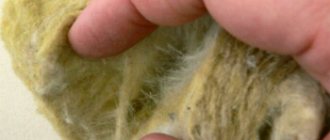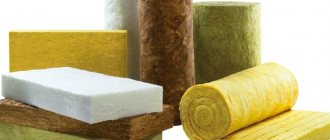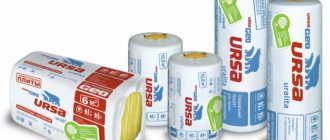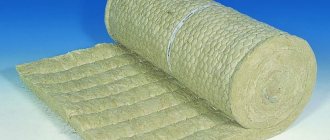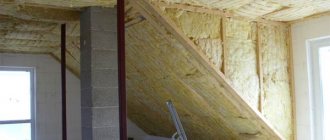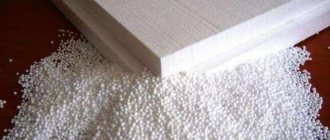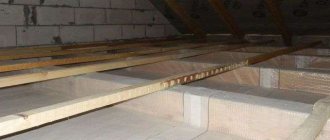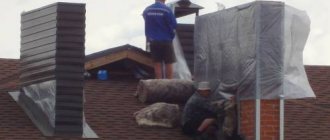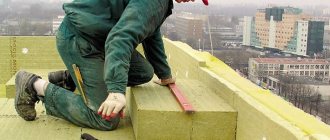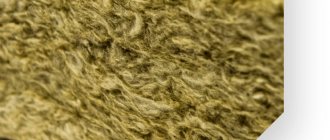Characteristics of basalt foil cardboard
The material has an insulating function for heat and sound. It has flame retardant properties, therefore it is safe in case of fire. Also, there is no absorption of moisture from the external environment, such a cardboard can withstand various temperature drops. The material does not collapse, does not exfoliate, does not oxidize, is not subject to vibration, and will not be spoiled by rodents. Its service life is from 50 years. Foil-type basalt cardboard can be cut with a knife, it bends easily and takes any required shape. This material is produced in sheet form, it is fixed with an adhesive composition, thanks to this, high-quality heat insulation is created. During cutting, it must be taken into account that the material can shrink when exposed to high temperatures. Thanks to the basalt fiber, the material has fire-resistant properties, and is safe in case of fire, as it does not burn.
Areas of use
It is used for internal and external heat, steam, sound insulation of walls, floors, ceilings in residential, administrative and industrial premises, hot and cold water supply systems, air ducts, ventilation and air conditioning systems, freezing and refrigerating chambers, tanks and reservoirs. The presence of reflective foil gives the maximum effect when insulating building structures and other objects near heat sources (insulation of baths, saunas, roofs of houses, heating systems and pipelines). Recommended for heat and vapor insulation of roofs, ventilation, exhaust and air conditioning ducts, metal structures. For thermal insulation of the roof, it is recommended to use foil insulation on both sides, then in the summer it will protect the under-roof space from overheating due to the reflection of external thermal radiation, due to the low thermal conductivity and high reflective characteristics of the foil, it reduces heat loss by 25% -30%, protects the walls from freezing blowing and dampness. The use of foil thermal insulation can significantly save on space heating.
Where is foil-coated basalt cardboard used?
Basalt foil cardboard is used to isolate heat in areas where furnaces and thermal devices are located. With the help of this material, pipelines, boilers, doors and dampers are insulated. Sheets of material are used as a heat-resistant layer between the oven and the floors, the chimney and the roof, that is, in those areas where there is a risk of fire. Basalt cardboard is used as a heat insulator in various industries, for example, mechanical engineering and others. The material can be used in construction, with its help, gaps and seams are insulated. It is also possible to insulate boilers and other heating devices, both electric and gas. This type of material is used to insulate external doors, balconies, and also insulate baths and saunas. It can be used to insulate interior and exterior walls.
Definition of self-adhesive insulation
Materials with heat insulating properties are also used in the construction and renovation of buildings as hydro- and noise-insulating coatings. The main working layer that provides heat retention is polyethylene foam, which can be protected on one or both sides with a thin layer of aluminum foil. If the foil layer is applied on one side of the thermal insulation, then the adhesive layer is applied on the reverse side of the material, and if the thermal insulator has two layers of foil, then the adhesive is applied to one of the aluminum layers.Prior to bonding, the adhesive layer is protected with paper or polymers, which prevent damage or temporary adhesion of the adhesive layer during storage or transportation of the insulation.
[ads-pc-2] [ads-mob-2]
Insulation docking
[ads-pc-3] [ads-mob-3]
The demand for such materials is provided not only by their small thickness, but also by the fact that the self-adhesive insulation can be fixed to the surface without any tools and devices: it is enough to peel off the protective layer of paper. In addition, self-adhesive materials are often used not only as the main insulating layer, but as an addition to traditional heat insulators - mineral wool, foam, etc.
Insulation brand Penofol
Advantages of self-adhesive insulation:
- The minimum coefficient of thermal conductivity at the same minimum thickness of all known heat insulators;
- High reflectivity of light and heat energy with a foil-coated protective layer;
- Due to the foiling of the surface, the material does not pass moisture and has a 100% vapor barrier;
- Any self-adhesive insulation is very easy and quick to install - you just need to glue it onto a clean protected surface;
- A variety of options for the execution of foil-clad heat insulators (rolls, tapes, strips, patches) allows you to choose the right brand for any type of work and for any surface;
- Considering all the above characteristics, we can talk about the cheapness of the material: self-adhesive materials with a foil surface are quite competitive with traditional heaters, but they are many times superior in their qualities and parameters.
Self-adhesive tape material
[ads-pc-2] [ads-mob-2]
This is interesting: Only self-adhesive foil insulation reflects heat energy outward in the warm season, and a feast of negative temperatures retains heat energy in the house. For comparison: traditional heaters have this effect only in 3% of the volume of foil self-adhesive. If self-adhesive materials are used for external insulation, then it is first recommended to stick a perforated film material on the surface in order to avoid wetting the battens or frame when steam is generated from moisture contained in the air.
Installation of thermal insulation
Non-combustible foil mats made of mineral basalt wool with a protective coating
Lined aluminum mats are used for thermal insulation of tanks, containers, pipelines, industrial equipment. Working temperature of use - from -196 ° С to + 400 ° С, mats can be used only in closed rooms. For outdoor work, other mats can be made on special order, heat-insulating mats have a wide range of applications. Namely: pipelines of heating networks, water supply, chimneys, tanks, reservoirs, main, industrial pipelines, pipelines with superheated steam.
Mats can be used throughout Russia, the CUTWOOL®MP-Protect coating has fire safety certificates, GOST R.
A lot of different information is available on the Internet on the subject of the use of mineral wool basalt mats with a protective coating. We will also contribute to this noble cause - educating consumers about the various nuances of thermal insulation. As practice shows, buyers of this excellent thermal insulation can let it in various parts of their facilities. This, as they say, is everyone's business - where, how to use foil-clad thermal insulation, but still, let's say a few words.
The point, you see, is that even specialists can be wrong, this is not the result of their lack of education. But there is simply such a tendency - not to particularly check information obtained from sources reliable for a particular specialist.We are talking about the fact that there were cases when mats of foil-clad mineral wool insulation were used to insulate floors. At the same time, pouring the screed from DSP (cement-sand mixture) from above, arguing that the foil will reflect heat.
But, at the same time, no one has ever bothered to make control holes in the screed to check the entire "pie". So the people went "an innovative invention to insulate the floor", while there is no mass character, but people believe in the result. So what happened in this minvat, cement-sandy "pie" that does not give the result the "Kulibins" needed ?! The answer for experts in chemistry, for sure, is obvious - the foil, so to speak, “burned out” from the chemical action of cement.
The heat is undoubtedly retained by the mineral basalt wool, but the foil that was so hoped for has "gone into the cement." From the above, we conclude that you need to use the products for their intended purpose, not try to be smarter than the manufacturer. In the laboratories of the manufacturing plant, before releasing the first trial batch, the products were subjected to various physical and chemical tests. We offer all interested persons, organizations, enterprises to purchase from us non-combustible foil mats made of basalt mineral wool!
Materials used as non-combustible insulation
1. Basalt mineral wool is a fibrous, fire-resistant and sound-proof material that is obtained by melting metallurgical mixtures. It not only does not burn, but also does not change at high temperatures. Today it is the most actively used material for warming houses, facades, ceilings, etc. It is worth paying attention to the cost of cotton wool. The cheap one, as a rule, has lower fire safety indicators. The material is environmentally friendly and safe for health.
2. Foam glass is made up of the smallest cells. It is made from broken glass. Its low flammability allows the use of such material on operating units.
3. Glass wool. It does not burn and is reasonably priced. Crafted from broken glass. The disadvantages include the risk of damage to the skin in the event of a violation of production technology. Cotton wool has greater strength, heat resistance and hygroscopicity than basalt analogue.
It is worth noting that it is possible to choose the right non-combustible insulation only with an accurate determination of the place of application. It also dictates the form of release of this material. In shape, it can be backfill, blocks, cotton wool, rolls, mats, plates, foil and liquid.
Basic rules for laying basalt foil cardboard
- Basalt foil cardboard is stacked end-to-end, and the seams are closed with special tape to obtain a one-piece reflective surface.
- Fixation is carried out using adhesives and a stapler. Some materials have an adhesive side, thanks to which the installation is easy and does not take much time.
- Laying of finishing materials is carried out on a crate of wooden or metal elements, this will help to avoid further deformation of the surface.
- When performing work, it is necessary to take into account the shrinkage of the material during heating.
- The foil side should be directed towards the interior of the room so that the heat is reflected into the room.
- Between finishing and insulation, it is necessary to maintain a gap of up to 25 millimeters, this allows air to accumulate. At the same time, the finishing material will not deform due to heating of the foil, and heat loss will decrease.
- When using an adhesive for fixing, it is applied in a dotted manner.
- If the surface is uneven, then you can build two lathing structures, one for fixing the insulation, and the second for the finishing material, while maintaining the gap between the surfaces.
- Before laying basalt foil cardboard, the surface must be cleaned, leveled if possible, and primed.
- When using a stapler, the material is fixed with staples, and the seams are closed with special tape, which has a reflective surface.
Basalt foil cardboard is used to insulate baths and saunas, as well as living quarters, while heat and noise are insulated. With proper styling, you can achieve the desired results, only all of the above rules must be observed.
Is it possible to use basalt insulation for a chimney
Basalt, used in the manufacture of chimneys, is one of the types of mineral insulation. Another name for the material is stone wool. Thermal insulation is made from gabbro-basalt rock waste. During the production process, the rock is crushed and melted, stretched into thin fiberglass.
The melting temperature in the furnace is 1500 ° C. The thickness of the pulled fibers is not more than 7 microns, the length is 5 cm. The resulting threads are passed twice through a press, preheated to 300 ° C. The resulting thermal insulation is distinguished by fire resistance, environmental friendliness, strength and other characteristics. It is not surprising that the largest manufacturers use fire retardant basalt insulation for chimneys.
Characteristics of basalt fiber for chimney
Thermal insulation of the chimney with basalt wool, given the characteristics of the material, is quite justified. During the production process, the material acquires the following advantages:
- Low thermal conductivity - depending on the brand, the thermal insulation value of the material ranges from 0.032 to 0.048 watts per meter per Kelvin. Foamed rubber, expanded polystyrene, cork have the same characteristics.
- Hydrophobic - moisture settles on the surface and cannot get inside. Even in damp rooms or under the influence of atmospheric precipitation, stone wool retains its operational and thermal insulation characteristics. Therefore, the choice of basalt wool for insulation of a chimney installed outdoors is a really good solution.
- Fire resistance - basalt wool, without loss of strength, heats up to a temperature of 1114 ° C. At a higher temperature, the material begins to melt. This ability allows you to withstand even direct exposure to open fire. The temperature of the chimney, even when soot is ignited, does not exceed 1000 ° C, therefore basalt is suitable for insulating any smoke evacuation systems, regardless of the principle of operation and the type of fuel used.
- Strength and resistance to subsidence - the stone wool fibers are located both vertically and horizontally, which leads to the ability to withstand compressive loads from 5 to 80 kilopascals. During the entire service life, the material does not change its shape. Deformation is allowed no more than 10%.
Where is basalt used in chimney systems
The characteristics of basalt fiber made it possible to significantly expand the scope of application, in comparison with conventional mineral insulation. In chimney systems, stone wool is used for the following purposes:
- Sandwich pipes - insulation of a steel chimney with basalt wool is carried out at the factory, which ensures high thermal performance and the absence of cold bridges. The construction of a sandwich pipe is distinguished by its light weight, heat resistance and good thermal performance.
- Ceramic pipes with an outer casing made of stainless steel - cylinders of basalt wool, 3-4 mm thick, are inserted into the structure. The absence of seams increases the already high thermal insulation characteristics. Ceramics installed in expanded clay concrete blocks are insulated during installation. You can wrap the chimney pipe with insulation with a thickness of 30/40/50 mm. Fix the cotton wool with clamps.
- Insulation of pipes of a single-wall steel chimney with basalt wool.For these purposes, it is recommended to use foil-clad basalt for the chimney. Foil stone wool reduces heat loss and protects the pipe from external influences of atmospheric precipitation.
- Insulation in penetrations - roof cutting for the chimney, as well as the passage in the floor slabs, in accordance with the requirements of PB and SNiP, is insulated with a non-combustible material. The gaps between pipes and structures are filled with stone wool. Fireproof foil-clad basalt insulation for chimneys is also used for the manufacture of fire-prevention cutting, protecting wooden elements of the building with it, located in the immediate vicinity of heating surfaces.
- Insulation of the chimney box - in order to prevent the appearance of oxides on brick channels, it is required to insulate the walls. For this purpose, rigid basalt slabs are optimal, allowing you to subsequently finish under plastering, laying ceramic tiles, etc.
Positive properties of foil-clad basalt cardboard
- The material is environmentally friendly, does not emit toxic substances when temperatures change, therefore it can be used in various industries.
- Since the material has a random arrangement of fibers, its insulating qualities are increased. Thanks to its use, noise and heat loss can be significantly reduced.
- The material is made from basalt fiber, which naturally bonds with each other, so it is non-flammable and safe when used in high temperature areas.
- Basalt material is resistant to moisture and temperature changes, does not deteriorate, does not rot, is resistant to mechanical stress, and has a long service life.
- This type of material is not exposed to the appearance of insects and rodents, does not collect mold and fungi.
- Basalt foil cardboard is not affected by chemical reactions, it is resistant to vibration processes.
- The material is easy to use, as it can be cut with a conventional knife, and is lightweight.
- Installation can be done independently, without the involvement of specialists, this will help save on costs.

